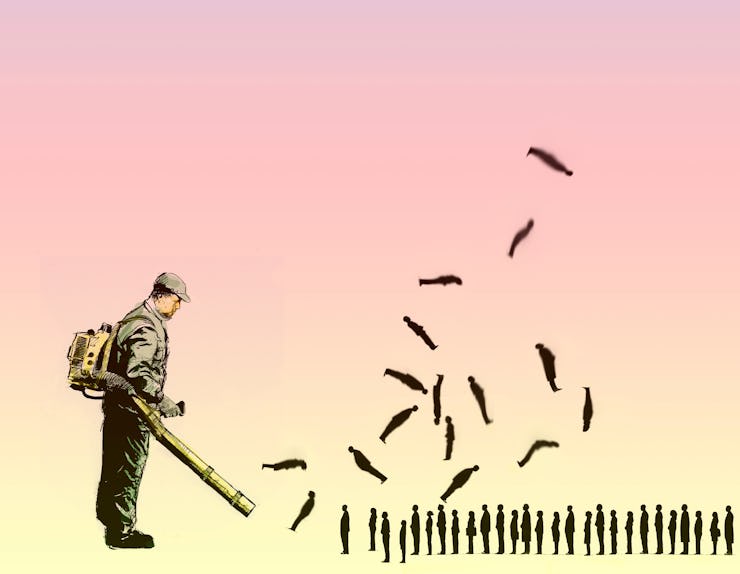How to avoid laying off the top talent at your company, the scientifc way
Outdated, non-strategic termination practices are hurting some companies try to stay afloat.

Especially during economic downturns like the one the world is experiencing with the Covid-19 pandemic, companies turn to layoffs to survive. But the way organizations are downsizing is ultimately costing them up to hundreds of thousands of dollars in future losses, according to a workforce development expert and organizational psychologist.
Katy Caselli, founder and president of consulting firm Building Giants, LLC, (clients include Revlon, Bosch and Kellogg’s)based this finding on her experience with clients as well as her own aggregate research project that summarizes 59 other studies (an abstract of one can be found below). She said she found that when organizations utilize layoff strategies such as last-in, first-out, or even at random, they tend to let go of middle and top performers, instead of focusing strictly on bottom performers.
“The research shows us that bottom performers lose companies money with every paycheck,” she says in a statement released alongside the research. “For example, a performer in the bottom 15 percent of the organization is actually losing their employer 40 percent of what they are paid.” In real-world numbers, that’s an employee being paid $50,000 per year for $30,000 of work.
"A performer in the bottom 15 percent of the organization is actually losing their employer 40 percent of what they are paid."
Prior to the pandemic, the labor market was seen as the tightest it’s been for years. The rate of Americans who had a job or were looking for one hit a more than five-year high last year, Reuters reported. That left organizations with roles they couldn’t fill for two to three years, Caselli said. Now that things have shifted the other way, it gives companies a chance to move weak employees out and replace them with better performers, who she said is worth up to 140 percent of what they are paid.
“Now is the opportunity to shrink costs intelligently, by removing the poor performers companies have had to put up with during the tight labor market that ended in March of 2020,” Caselli says. “But the data I’ve collected shows a continuing trend in outdated, non-strategic termination practices, leaving companies in a weakened position.”
"A performer in the bottom 15 percent of the organization is actually losing their employer 40 percent of what they are paid," Caselli reasons. In real world numbers, that’s an employee being paid $50,000 per year for $30,000 of work.
Caselli tells Inverse she wants “companies to be able to prune intelligently and grow intelligently. By 2021 to 2022 they can add a lot of value to their bottom line.”
But how exactly do organizations go about doing this? Each employee needs to be evaluated on a 100-point scale on each skill in their job description. Using these numbers, the evaluators would calculate an overall grade, with a 75 barely passing. With this number in hand, organizations can decide whether to let the person go, move them into another position or promote them if they excel at their current job. This process should also be used for new hires, utilizing behavioral interviews to evaluate job candidates on qualities including persistence, agility, innovation, high judgment and personal drive.
"It’s about what skills the person brings."
“It’s about what skills the person brings, their competence and whether they meet the company’s needs,” Caselli said. “Do they justify their paycheck? It has to be a firm yes or no. This is the only way companies should downsize.”
The alternative, she argues, results in the loss of top performers, and a continued drag on productivity with the continued employment of poor performers.
“Some organizations are OK with mediocre as long as they don’t do anything egregious,” Caselli said.
“But that loses them money.”
Abstract: This integrative conceptual review is based on a critical need in the area of performance management (PM), where there remain important unanswered questions about the effectiveness of PM that affect both research and practice. In response, we create a theoretically grounded, comprehensive, and integrative model for understanding and measuring PM effectiveness, comprising multiple categories of evaluative criteria and the underlying mechanisms that link them. We then review more than 30 years (1984–2018) of empirical PM research vis-à-vis this model, leading to conclusions about what the literature has studied and what we do and do not know about PM effectiveness as a result. The final section of this article further elucidates the key “value chains” or mediational paths that explain how and why PM can add value to organizations, framed around three pressing questions with both theoretical and practical importance (How do individual-level outcomes of PM emerge to become unit-level outcomes? How essential are positive reactions to the overall effectiveness of PM? and What is the value of a performance rating?). This discussion culminates in specific propositions for future research and implications for practice.
NiMBLE is a regular series from Inverse. Every executive talks about it. NiMBLE is how to be about it. Strategy guides, C-Suite interviews, digestible reports on the latest scientific research for high-performing businesses, and essential stories about enterprising leaders, from the editorial staff of Inverse.